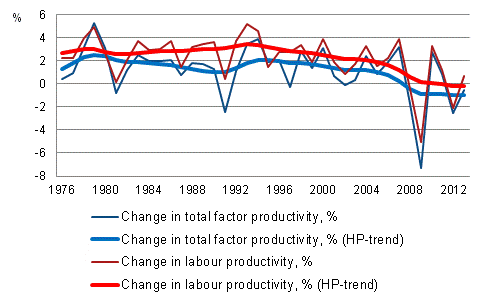Published: 28 November 2014
Development of productivity in the national economy 1976-2013
Based on preliminary national accounts data, the growth rate of labour productivity in the whole national economy was 0.6 per cent in 2013, having been -2.1 per cent in 2012 and 1.2 per cent in 2011. The respective growth rate of total factor productivity was -0.5 per cent in 2013, having been -2.6 per cent in 2012 and 0.8 per cent in 2011.
Development of productivity in the whole national economy 1976-2013*, %

*) The figures for 2012 and 2013 based on preliminary information
The Hodrick-Prescott filtered long-term growth trend (HP) indicates that the pace of growth in labour productivity has slowed down strongly in the whole economy since the mid-1990s, from 3 to 3.5 per cent to -0.2 per cent in 2013 (Fig. 1). Although the annual growth rates for individual years (2000, 2004, 2007 and 2010) have been around three to four per cent, the trend in labour productivity has been declining since the mid-1990s.
The long-term growth trend for total factor productivity shows that total factor productivity fluctuated between 1.5 and two per cent before 1993. Between 1993 and 2000, total factor productivity grew at the average rate of approximately two per cent per annum. Since 2000, the growth trend of total factor productivity has clearly slowed down.
Table 1 shows average annual changes of total factor productivity and labour productivity in different time periods. In addition, the table shows capital input, worked hours and labour composition contributions to value added growth, as well as capital intensity change and labour composition change contributions to labour productivity growth.
The contribution of labour composition to value added growth was strongest during the 1990s (0.7-0.8 percentage points per year). In the other periods, the contribution of labour composition to value added growth has been 0.1 to 0.2 percentage points per year. The contribution of capital intensity growth to value added has been fairly stable at an average of 0.8 to 1.2 percentage points per year. Growth has been lower only during the periods 1990 to 1994 and 2009 to 2013, about 0.3 and 0.4 percentage points per year.
Average growths of productivity in the whole national economy, 1976-2013*, %
| 1976-1989 | 1990-1994 | 1995-1999 | 2000-2004 | 2005-2008 | 2009-2013 | |
| Value added volume, change, % | 3,4 | -0,7 | 4,7 | 3,0 | 3,2 | -1,6 |
| Capital input contribution, change, % | 1,2 | 0,3 | 0,8 | 1,1 | 1,0 | 0,4 |
| Worked hours contribution, change, % | 0,4 | -3,2 | 1,5 | 0,4 | 1,0 | -0,7 |
| Labour composition contribution, change, % | 0,0 | 0,7 | 0,8 | 0,2 | 0,1 | 0,1 |
| Multi-factor productivity, change, % | 1,9 | 1,5 | 1,6 | 1,3 | 1,0 | -1,4 |
| Capital intensity contribution, change, % | 1,0 | 1,4 | 0,0 | 0,9 | 0,7 | 0,9 |
| Labour composition contribution, change, % | 0,0 | 0,7 | 0,8 | 0,2 | 0,1 | 0,1 |
| Labour productivity, change, % | 2,9 | 3,5 | 2,4 | 2,4 | 1,8 | -0,4 |
The productivity database EUKLEMS aiming at international comparability has also been updated for Finland according to the new Standard Industrial Classification (TOL2008). The productivity indicators presented in these statistics are based on the KLEMS method and to the same raw data as EUKLEMS, but the methods differ somewhat from those of the EUKLEMS database. A database suitable for international comparisons of productivity can be downloaded at: www.euklems.net .
Source: Productivity surveys 2013, Statistics Finland.
Inquiries: Jan Klavus 029 551 3391, Antti Pasanen 029 551 2629, kansantalous@stat.fi
Director in charge: Leena Storgårds
Publication in pdf-format (170.7 kB)
- Tables
-
Tables in databases
Pick the data you need into tables, view the data as graphs, or download the data for your use.
Updated 28.11.2014
Statistics:
Productivity surveys [e-publication].
ISSN=2343-4333. 2013. Helsinki: Statistics Finland [referred: 16.12.2025].
Access method: http://stat.fi/til/ttut/2013/ttut_2013_2014-11-28_tie_001_en.html

